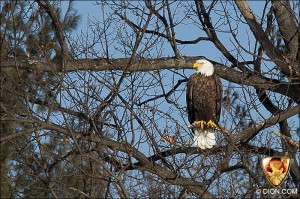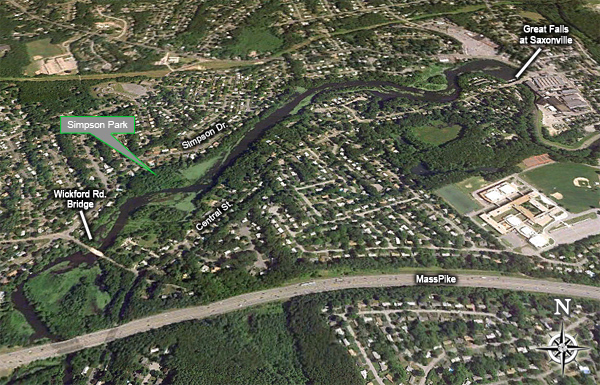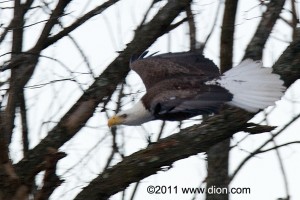Eagles Feeding at Sudbury River

One of a pair of American Bald Eagles photographed on the banks of the Sudbury River in Framingham on January 31, 2011. (Photo courtesy of Wayne Dion, www.dion.com)
FRAMINGHAM, MA - On Sunday, (January 30, 2011), Framingham photographer Wayne Dion spotted an American Bald Eagle near the Sudbury River by Central Street in Saxonville.
Unfortunately, he didn't have enough time to photograph the bird that day.
The following morning, (Monday, 1/31/2010), at 8:00am, Dion was on his way out to an appointment, but took time to look for the eagle. To his surprise, he spotted not just one, but a pair! He briefly photographed them, then went to his appointment.
While the early bird may get the worm, it's the early photographer that gets the bird!
When he returned about an hour later he spotted the pair further west on the river near Simpson Park. At one point both eagles were sitting together on a single branch, (which likely indicates they were mates, rather than just two eagles traveling and hunting together).

The Sudbury River winds through Framingham, MA. The area shown is where Wayne Dion spotted and photographed a pair of American Bald Eagles on January 30th and 31st, 2011. (Image based on Google Earth rendering of area).
Before he could shoot [photos of] the pair, one left the perch and flew down to the partially ice-encrusted bank of the river where Dion observed the bird eating "something".
Dion waded through the knee-deep snow into Simpson Park, attempting to get closer to his subjects -- but was likely spotted by the birds which have eyesight that's 3x to 4x stronger than a human's, (eagles can also rotate their heads up to 270 degrees making it very difficult to sneak up them!)

Hopefully for the eagle, that isn't a fish from the Sudbury River he's been eating. The river is posted with "Do Not Eat Fish" signs, warning humans of the potential danger from mercury contamination from the NYANZA Chemical Co., in Ashland which dumped dyes and other heavy metal laden chemicals including 100,000 lbs. of mercury into the river. It should be mentioned that at that time in history, even Framingham's own Roxbury Carpet Mill dumped dyes into the river. Late into the 1970's the river below the Great Falls at Saxonville would run red, green, blue or whatever color they were dyeing at the mill that day. (Photo courtesy of Wayne Dion, www.dion.com)
Dion was able to photograph the birds in-flight, sitting, and standing. His camera was only equipped with a 300mm lense, so couldn't get very detailed close ups, but said he believed one of the eagles may have been tagged on the ankle.
Scared off by Dion, or simply through with their breakfast in the park, at 9:30am, the pair flew off, and Dion went to unload his cameras and publish the photos onto the web.
While eagles range across the entire continental United States, their preferred habitat is in old growth trees near large lakes or other bodies of water that have at least 4 to 5 square miles of surface area. The birds of prey will often nest year-round, even in colder regions so long as their preferred diet of fish is available. Eagles will migrate in search of food if the body of water they fish from freezes over. With this winter's freezing temperatures, chances are the pair traveled to Framingham from a home further north in New England or from the western part of Massachusetts.
American Bald Eagles were nearly driven to extinction by "DDT", a chemical pesticide used widely in the 1950's and 1960's. DDT, which was frequently applied via aerial spraying also washed into nearby waterways. The DDT concentrated in the sediment which contained bacteria and microscopic water-borne plants which small fish fed on. Larger fish, in-turn ate those smaller fish causing the concentration of the DDT to build up in the fleshy tissue of larger fish. The larger fish were in-turn eaten by eagles, (and many other types of birds). The DDT caused the eagle [and other bird's] eggs to have shells that were too thin to support reproduction.
In 1972, due to early environmentalist concerns, especially regarding the links to Bald Eagle mortality, DDT was completely banned in the US. (Further studies found the pesticide to be a carcinogen and cause of several human illnesses).

One of a pair of eagles sighted in the Central St., Wickford Rd, Sudbury River area of Framingham. (Photo courtesy of Wayne Dion, www.dion.com).
Efforts since to protect and restore the eagle population have been successful. In 2007 the Bald Eagle, (Haliaeetus leucocephalus), was taken off the Endangered Species List, no longer considered endangered or even "threatened", but they do remain protected against hunting by U.S. Federal Law.
About the Photographer:
Wayne Dion, (of Dion & Company), is a professional photographer who resides in Framingham on the banks of the Sudbury River. His firm specializes in commercial photography with a focus on construction and architectural images, product photo shoots, automotive photography, commercials images of people and other subjects ranging from microscope enhanced photos of tiny items to striking aerial photograph of vast landscapes. The company produces deliverables for use in print, online and interactive graphics. Dion & Company provides complete graphic design for collateral pieces as well as web design services. For more info, or to see an online portfolio of Dion's work, visit: www.dion.com
Other Resources:
- www.eagles.org - American Eagle Foundation.
- www.iucnredlist.org - International Union for Conservation of Nature and Natural Resources, species survival guide.
- www.nwrc.usgs.gov - U.S. National Wetlands Research Center, (bald eagle habitat suitability index).
- www.epa.gov/region1/superfund/sites/nyanza/ - Nyanza site info at U.S. Environmental Protection Agency (EPA).
- earth.google.com - Google Earth, 3D mapping, (requires software download to use).
###
